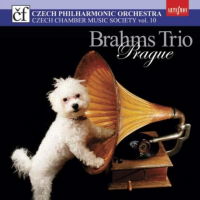
Unique Timbres
A recording by
The Brahms Trio Prague,
reviewed by
GEORGE BALCOMBE
ArteSmon AS 726-2
|

|
In 2005 three of Prague's prominent young musicians formed an ensemble of piano, violin and French horn -- the Brahms Trio Prague. The group flourished so rapidly that by 2008 it was able to commission new works in addition to performing well known pieces such as Brahms' E flat trio of 1865.
Listen -- Brahms: Adagio mesto
(track 10, 0:01-0:56) © 2008 ArteSmon
This CD opens with the Brahms Trio's first commission -- the three movement sonata by the English composer Andrew Downes, who is a twenty-first century descendant of the great English modal polyphonists such as William Byrd and Thomas Tallis. In his Horn Sonata, Downes preserves the mystery of modal sounds but does so within the structures of nineteenth century chamber music. The listener is consequently confronted with the unanswerable question: 'Is sonata form compatible with free-flowing polyphony?' The problem seems exacerbated by the fact that piano, violin and french horn do not go well together. Downes tries hard to make viable music out of first and second subjects, development sections, recapitulation and so forth. However, it seems never shall the twain meet between diatonics and polyphonics.
Listen -- Andrew Downes: Allegro molto
(track 3, 1:09-2:03) © 2008 ArteSmon
Downes is followed by a four-movement Trio by Heinrich von Herzogenberg, a diatonic gentleman if ever there was one, who not only rose to the heights of the nineteenth century teutonic universe but also co-founded founded the Bach Society.
Listen -- Herzogenberg: Allegretto
(track 4, 5:37-6:45) © 2008 ArteSmon
The sole thing of any interest about Professor Herzogenberg is that he originally scored his trio for oboe, horn and piano, not the violin. The oboe sound would have added penetration and attacca to the ensemble and the result of that would have been to ensure the audibility of each instrument's unique timbre.
The essential technique of composition in a horn trio is to devise motifs with which to create the sonic illusion that all three instruments are compatible, when, in fact, they are not. Unfortunately, the effect of the motifs on each of these trios is to muffle the potential of the instruments.
This CD's final work is the well-known and well-loved Brahms horn trio in E flat Op 65. Listeners either have to love or leave this work. It might be worth pointing out, however, that Brahms' melancholic third movement adagio mesto, might do well if exploited by recording companies which produce popular one-off items such as the Sibelius Valse Triste, the Saint-Saëns' Swan from The Carnival of the Animals, or, at greater length, for those gifted with longer attention span, Wagner's Liebestod from Tristan und Isolde. After all, why not? They are all beautiful.
On this CD the players have taken control of the recording process themselves, using a simple stereo-pair microphone arrangement, and recording equipment placed on chairs beside them on the platform. The trio's horn player Ondrej Vrabec was responsible for the editing and mastering. The result is a clear recording of fine performances, which goes some way towards solving the problems inherent in the music itself.
Copyright © 23 December 2008
George Balcombe, London UK
 BUY CLASSICAL CDS ONLINE
CD INFORMATION: BRAHMS TRIO PRAGUE
BUY CLASSICAL CDS ONLINE
CD INFORMATION: BRAHMS TRIO PRAGUE
Record Box is Music & Vision's
regular series of shorter CD reviews
| 
